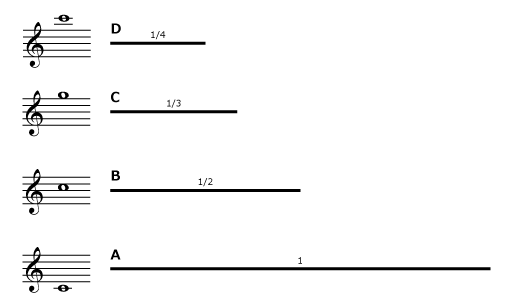Musical Glossay
The Farthest Castle of the Unknown World [Now on Sale!]
There is another world unknown to the Farthest Castle of the year 2014 All Japan Band Music Competition. It is not just a revised version or a rearrangement. You will witness the parallel world! →Full Score, Parts & some benefits
perfect interval
Difference in pitch due to a simple combination of natural overtones. In the case of string instruments The length of the string is the wind instrument If the length of the pipe is halved the pitch increases by one octave. When it is 1/3 of the length, the difference in pitch will be 1 octave and 5 degrees complete from the pitch of the initial length. And when it is 1/4 it is half the half so it will be 2 octaves. Pitch that combines these intervals. There are the same degree (same sound), complete 4 degrees (pitch difference between C and D), complete 5 degrees (pitch difference between B and C), complete 8 degrees (pitch difference between A and B) for complete pitch. This pitch melts well and you almost can not hear it as a single sound.

Instructions for gesthat rendition are various and may be indicated by letters, sometimes "+" above or below the note. When returning to normal playing method, write "o" or written as open, offen, ouvert etc. Also, when instructed as "+", the next not playing sound is returned to the normal playing method. There is a geste top mute for cases where gesthat performance is difficult depending on the size and range of the hand, but it is somewhat different from the real gesh top.
How to use the "+" sign may differ depending on the composer. In most cases it represents Gesht playing style, but in rare cases it may mean muting. Although it is difficult to distinguish it, it is difficult to distinguish between the relationship between the front and back (attaching mute, taking time to remove, etc considered) and the relationship with other parts (such as whether the same sign is used other than horn), the character of music (What tone color, volume is preferable, etc.), and the like. The sense of the performer is questioned. After that, there is no choice but to ask the composer himself.
Index to page top
| 音楽の本 | |
|---|---|
 | 独・仏・伊・英による音楽用語辞典 【改訂版】 |
 | これで納得!よくわかる音楽用語のはなし―イタリアの日常会話から学ぶ – 関 孝弘 (著) |
 | 持ち歩き 音楽記号事典 – 多田 鏡子 (著), 川島 素晴 (監修) |
 | 音楽の科学---音楽の何に魅せられるのか? – フィリップ ボール (著), 夏目 大 (翻訳) |